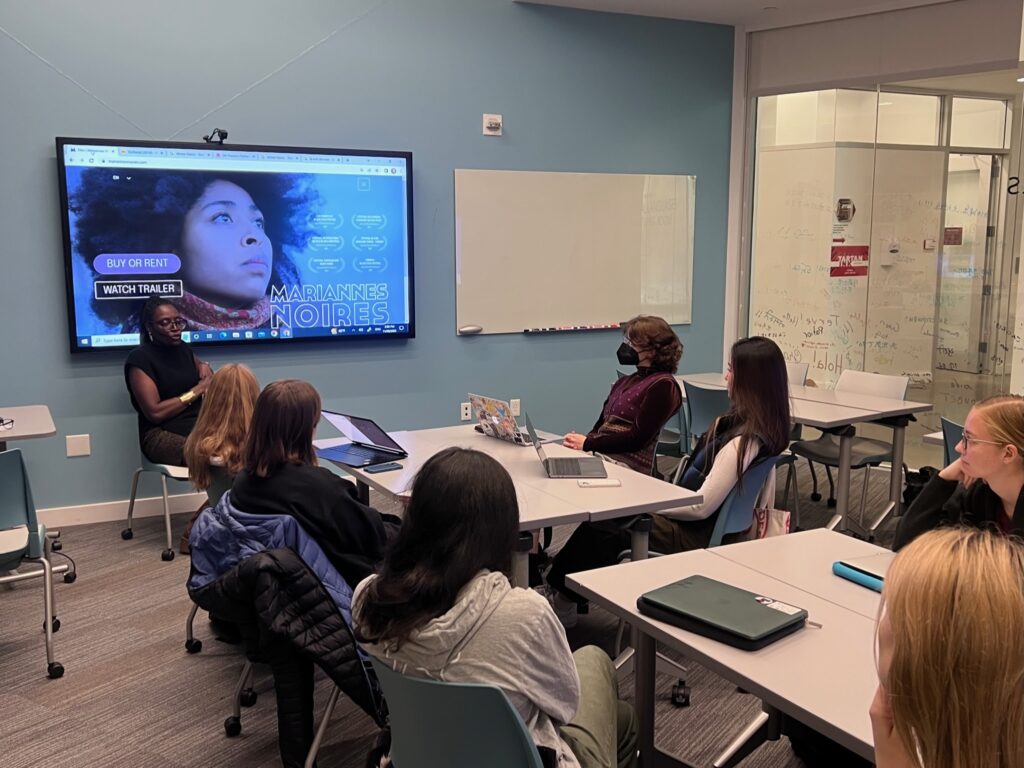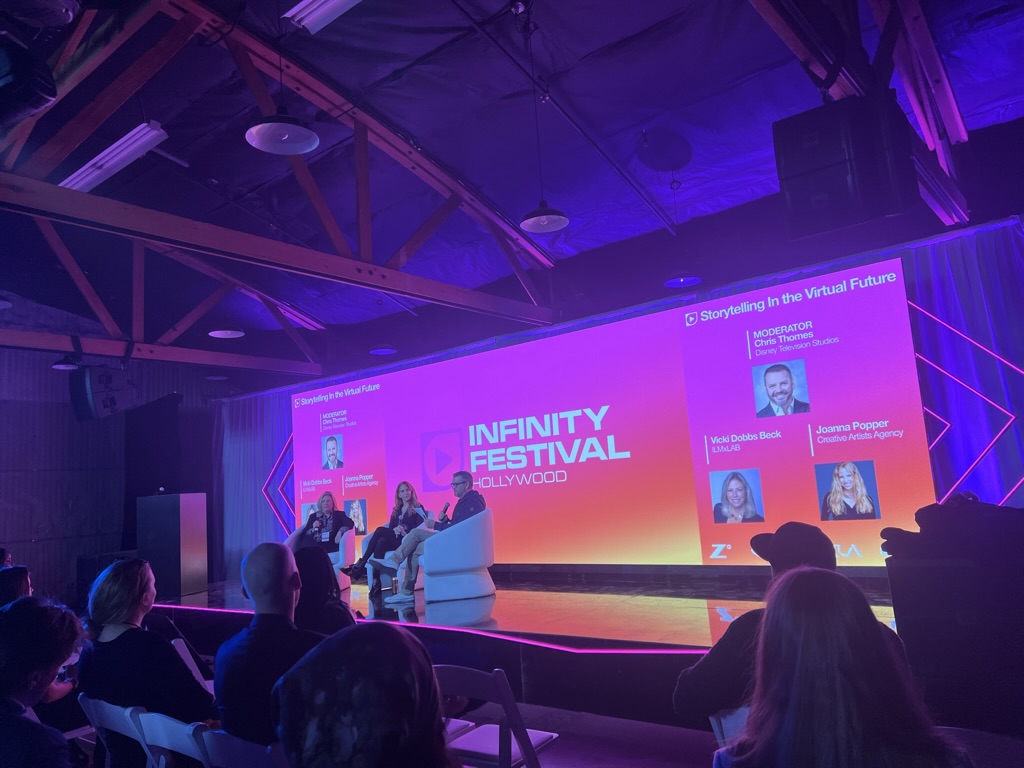Research-Based Creative Activity
The Global Languages and Cultures Room serves as a space to explore pedagogies of learning and approaches to creativity using immersive technologies. As Director I curate projects that offer insights into the potential of these technologies for teaching language and culture, and addressing challenging topics like identity and intercultural learning. The following is a sample of the projects I have led, fostered, and curated in the room.
Kaleidoscope, developed in 2020 and adapted with funding from the Eberly Center and CMU’s Simon Initiative, explores unconscious (cultural) bias. The project has been successful, running in the room from drop-in visitors and also being used to facilitate workshops and teaching sessions. Students actively participate, sharing reflections and engaging in discussions about unconscious bias, cultural differences, and the nature of the experience. This project has set a template for future installations.

The Other Side is a project developed through the ETC, incorporating projections onto glass, enabling questions, polls, and media display. Although the pandemic disrupted its progress, the software platform and hardware components have been developed. However, certain aspects, like projection brightness, remain unresolved. Testing a modified version of the project is planned for Fall 2023, with summer preparations to experiment with alternative projectors and switch control to handheld mobile devices.
Intertwined is a new project exploring storytelling, sharing, and secrets. Combining digital projection with an old analog telephone, the installation guides users through a narrative introduction before inviting them to contribute personal recollections and memories to an archive of oral histories. The project aligns with the room’s mission of providing a safe space for discussing difficult subjects and promoting acceptance and openness around issues of identity. The installation opened in May 2023, with expectations of evolving based on visitor experiences and feedback.
CMU offers numerous groups, institutions, studios, and initiatives that support events, workshops, festivals, and projects. The Frank-Ratchye STUDIO for Creative Inquiry, in particular, aligns with the mission of the Global Languages and Cultures Room by fostering artistic, creative, and experimental outcomes. Both spaces work well together, promote events, share resources, and facilitate student projects, creating opportunities for future collaboration.
In Spring 2022, I took my first sabbatical semester and received teaching relief to travel and learn from institutions and organizations that work in immersive technologies. My first visit in February 2022 was to Washington DC, where I visited several institutions, including the National Museum of African-American Culture, the Museum of the American Indian, and The Arts and Industry Building, where immersive technologies, including projection, augmented reality, and virtual reality, are being used to tell stories about their artifacts and exhibits. The most innovative of these, with particular resonance to my work, was Planet Word, an interactive museum of language that included installations by the award-winning design company Local Projects, featuring, among others, interactive books, projection mapping, spatial tools for drawing, and writing, and innovative uses of audio and image.

This research has already begun to inform future creative projects for the room. For example, in January 2023, in collaboration with Prof. Anne Lambright, a Further-Fund Grant from the Frank Ratchye STUDIO for Creative Inquiry was awarded in January 2023. The grant supports an audio project that explores the life of Te Ata Thompson-Fisher, a Chickasaw storyteller and performer who attended Carnegie Tech from 1921 to 1922. Using research from the CMU Archives, the project aims to create an aural history of Te Ata’s time in Pittsburgh, incorporating archive recordings, found sound, and interviews.

Research, Scholarship and Collaborations
In addition to the aforementioned creative output, my scholarly activity has also increased since the last review, as I have continued further to establish a footprint and visibility in North America. I have had the privilege of presenting and leading sessions at various conferences, showcasing the work of the Global Languages & Cultures Room, and I have been able to establish a more robust writing regimen, which has led to a steady stream of publications. These experiences have allowed me to witness the evolution of our work, from discussing the room’s potential to reporting on content development, immersive technology usage, pedagogies employed, and the creation of relevant courses.
In the past five years, many institutions have looked at the increase in virtual reality and other immersive technologies to enhance visitor experiences. Through new courses, research, and the development of immersive projects, others, such as CMU, have created spaces for this exploration, such as the Global Languages & Cultures Room. I have been invited to visit and present at institutions across the country, where I have shared the GLCR’s pedagogical and creative work and research while learning from the work of peers.
In the past five years, many institutions have looked at the increase in virtual reality and other immersive technologies to enhance visitor experiences. Through new courses, research, and the development of immersive projects, others, such as CMU, have created spaces for this exploration, such as the Global Languages & Cultures Room. I have been invited to visit and present at institutions across the country, where I have shared the GLRC’s pedagogical and creative work and research while learning from the work of peers.
In Spring 2022, I was invited to visit the Texas Immersive Institute at the University of Texas in Austin. Directed by Professor Erin Reilly, the institute focuses on immersive projects in various fields, organizing Brain Jams or Hackathons for different industry sectors like Entertainment, Retail, and Health. We discussed challenges, opportunities, and ways to collaborate in this field, and in November 2022, together with Megan Elliott from the Johnny Carson Center for Emerging Media at the University of Nebraska, we were asked to establish an education track at the Infinity Festival. This three-day event in North Hollywood showcased the latest entertainment technology, including AI and Virtual Reality. It provided an opportunity for CMU, Texas, and Nebraska undergraduate students to meet industry professionals and colleagues from other institutions and discuss innovations in immersive technologies.

While in many ways, establishing these partnerships provides new opportunities to students, there are many events and conferences, such as Siggraph, Tribeca, IDFA, Venice Biennale, and SXSW, and it is important that the work of the Global Languages and Cultures Room feeds into these professional gatherings, and that students have the opportunity to attend them. Going forward, my goal is that the Global Languages & Cultures Room courses will yield more projects to be brought to the screen or showcased at such different venues and others. This year I am attending the Sheffield Documentary Festival and hope to be able to export various elements, including ideas for immersive pop-up spaces and screening programs, back to CMU so that we might launch our event as a fringe event of the CMU International Film Festival.
I have presented at various conferences in the US and UK, showcasing my expertise in immersive media for language and cultural learning. Notable among these is the American Association of Applied Linguistics (AAAL) Pre-conference Workshop in March 2022, where Prof. Sebastien Dubreil and I facilitated a one-day workshop titled “Using 3D Virtual Reality to Promote Critical Language and Cultural Global Competence.” Participants explored VR’s potential for language learning through playtests and group activities. Additionally, at the Modern Language Association (MLA) Conference 2023, Prof. Anne Lambright and I presented a poster highlighting the new Minor in Immersive Technologies for Arts & Culture in the MLA Innovation Room. In June, I will present “Immersive Technologies for Language and Culture: Blending a multiliteracies approach to Storytelling and Technology” at the CALICO 2023 Conference, the largest North American professional organization for technology-enhanced language learning. These conference experiences have helped expand my networks and deepened my understanding of the wider field. I am dedicated to further disseminating my work and exploring collaborations for future research projects.
I continue to seek out collaborators and provide expertise in the field of immersive storytelling. For example; I was recently invited to Harvard University by Prof. Nicole Mills, (one of our collaborators for the AAAL Pre-conference workshop, who also uses VR for language learning) to speak with her students in her Language Learning and Technology Course at the Harvard Graduate School of Education. During my visit, I was able to further connections between our institutions by working with Matthew Cook, Digital Scholarship Program Manager for the Widener Library, and Harvard Business School students and staff. Additionally, I connected with colleagues and graduate students working with immersive technologies at MIT’s MediaLab.

In July 2021, I also contributed to Games for Change’s XR Games Jam, joining a team to create a VR game that explored themes of content moderation, disinformation, and hate speech. Working as part of a team, we took on the roles of producer, designer, and writer; producing a prototype VR experience that could be viewed in a headset.
I have published six articles and chapters in peer-reviewed specialist publications such as the Bloomsbury Handbook of Technology Education, the CALICO Journal, and the Routledge Handbook of Language Program Development, and collaborated with the Digital Library Federation (DLF) on a toolkit of Lesson Plans on Immersive Pedagogy, which is published as an Open Educational Resource (OER).
I continue to write and contribute to public scholarship through my medium publishing account and weekly Substack newsletter (166 issues to date). I have received commendations and testimonials from readers for my personal newsletter, where I write about pedagogy, creativity, technology, and working in the US. Additionally, I publish my syllabi via my website https://dotsandspaces.uk/educatespaces/ and include a semester plan and reflections on my work. I think it is important to share openly, invite feedback, and work in a transparent manner.
